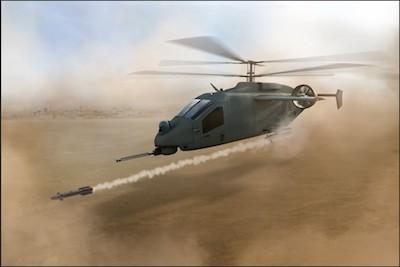Tue, Apr 16, 2019
Offering For U.S. Army’s Future Attack Reconnaissance Aircraft-Competitive Prototype
The AVX Aircraft Company and L3 Technologies have announced their innovative compound coaxial helicopter (CCH) design, which is competing for Phase 1 of the U.S. Army Future Attack Reconnaissance Aircraft (FARA)-Competitive Prototype (CP) program competition.

The innovative design solution will exceed the reconnaissance and light-attack mission of FARA with a high-performing and survivable platform. AVX-L3 CCH will meet 100 percent of mandatory requirements and exceed 70 percent of them. The CCH design, combined with rigorous engineering and production processes and certifications, will deliver a safe, performance-driven, affordable aircraft capable of operating in highly contested airspace and degraded environments for extended periods.
“This FARA-CP solution provides L3 and AVX an opportunity to demonstrate the agility and innovation that sets our team apart in support of the U.S. Army’s modernization priorities,” said Christopher E. Kubasik, Chairman, Chief Executive Officer and President of L3 Technologies. “We are collaborating to deliver a prototype that provides powerful leap-ahead capability for our warfighters at an affordable life-cycle cost.”
“We are extremely pleased to reveal the design for this very important U.S. Army program,” said Troy Gaffey, AVX CEO and Chief Engineer. “AVX and L3 provide unique engineering design skills and manufacturing expertise that will provide the Army with an advanced, lethal and affordable reconnaissance and light-attack platform.”
The companies’ next-generation single-engine design, paired with a wing for lift during high-speed forward flight, provides leap-ahead capabilities in a faster, lighter and more lethal aircraft that requires less maintenance through its life cycle, featuring:
- A fly-by-wire, side-by-side cockpit optimized for pilot efficiency
- Two ducted fans that provide forward and reverse thrust for both high-speed operation and agility
- State-of-the-art modern open systems architecture (MOSA)-based digital backbone and avionics systems
- A small form factor that meets C-17 loading and Navy DDG shipboard size limits through manually folding blades and wings
- Modularity that provides for component reuse and a high degree of systems commonality across all of the U.S. Army capability sets
(Image provided with Joint news release)
More News
He Attempted To Restart The Engine Three Times. On The Third Restart Attempt, He Noticed That Flames Were Coming Out From The Right Wing Near The Fuel Cap Analysis: The pilot repor>[...]
Make Sure You NEVER Miss A New Story From Aero-News Network Do you ever feel like you never see posts from a certain person or page on Facebook or Instagram? Here’s how you c>[...]
From 2009 (YouTube Edition): Leading Air Show Performers Give Their Best Advice for Newcomers On December 6th through December 9th, the Paris Las Vegas Hotel hosted over 1,500 air >[...]
Aero Linx: NASA ASRS ASRS captures confidential reports, analyzes the resulting aviation safety data, and disseminates vital information to the aviation community. The ASRS is an i>[...]
“For our inaugural Pylon Racing Seminar in Roswell, we were thrilled to certify 60 pilots across our six closed-course pylon race classes. Not only did this year’s PRS >[...]
 NTSB Final Report: Rutan Long-EZ
NTSB Final Report: Rutan Long-EZ ANN FAQ: Turn On Post Notifications
ANN FAQ: Turn On Post Notifications Classic Aero-TV: ICAS Perspectives - Advice for New Air Show Performers
Classic Aero-TV: ICAS Perspectives - Advice for New Air Show Performers ANN's Daily Aero-Linx (06.28.25)
ANN's Daily Aero-Linx (06.28.25) Aero-News: Quote of the Day (06.28.25)
Aero-News: Quote of the Day (06.28.25)



